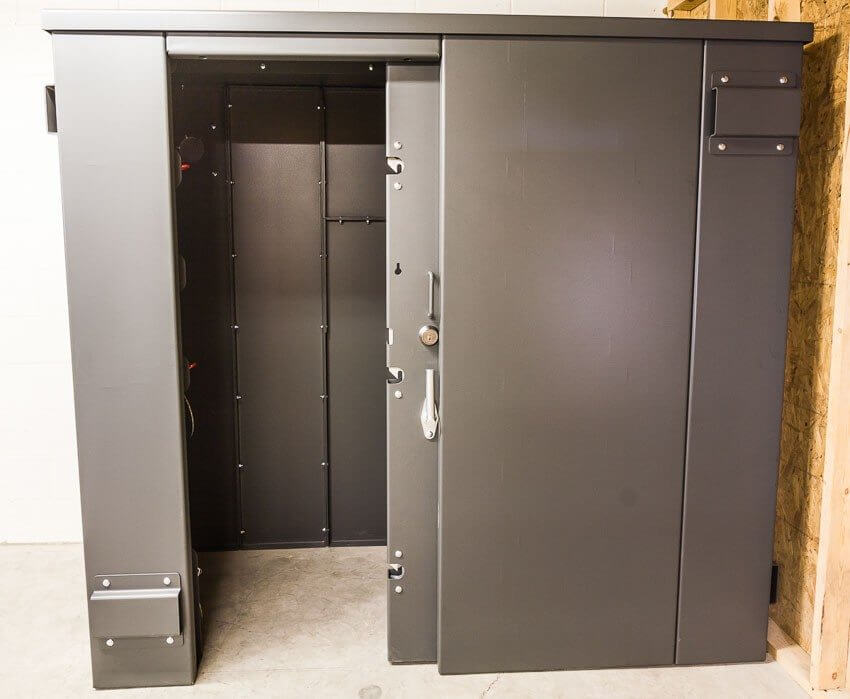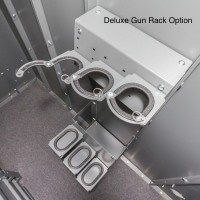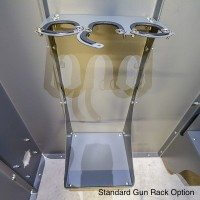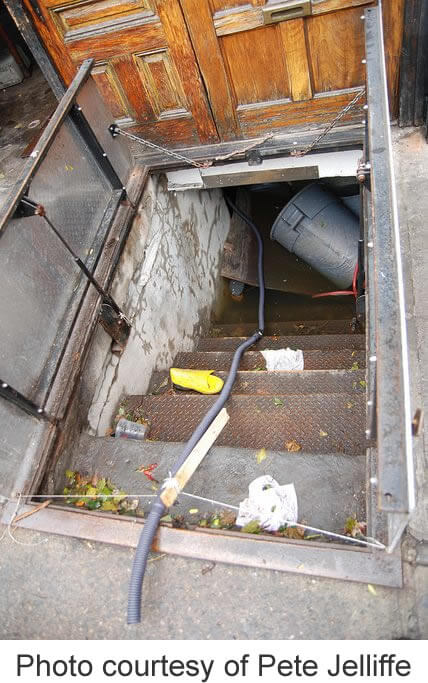6 Products
Above ground storm shelters have been around for quite awhile, but it’s only been in the last eight years that the United States has seen powerful enough storms (tornadoes and hurricanes) to verify their rigorous safety testing under real circumstances. The major tornadoes back in 2010 were a real eye-opener on how effective these storm shelters are - especially in comparison to underground storm shelters and basements.
Today, there’s still a large gap in information regarding the protectiveness that above ground storm shelters possess, so we’ve put together the following guide to highlight their superior defense against some of the most aggressive storms and intruders.
About Above Ground Storm Shelters
Traditionally, the majority of tornado shelters in the United States are below ground, so the newer above ground storm shelters have yet to receive a wide assessment by people living within major storm paths. It makes perfect sense to be secure below a tornado or hurricane instead of within its teeth, and what better shield to have than the earth’s own surface? You might be surprised, though. Being underground isn’t all that it's cracked up to be. We’re going discuss some of the pros and cons between below ground and above ground storm shelters.
Below Ground Shelters
 Riding out a catastrophic storm underground has always made sense: the wind, the debris, and the devastation all takes place above surface, so why not hide below it for protection, right? Lots of people feel this way, so the bulk of older storm shelters have been buried underground - usually with strong, locking hatch doors - to protect homeowners from extreme storms like tornadoes and hurricanes.
Riding out a catastrophic storm underground has always made sense: the wind, the debris, and the devastation all takes place above surface, so why not hide below it for protection, right? Lots of people feel this way, so the bulk of older storm shelters have been buried underground - usually with strong, locking hatch doors - to protect homeowners from extreme storms like tornadoes and hurricanes.
The construction for below ground shelter is fairly simple - usually constructed of concrete and rebar like a basement, and then enclosed on top with a steel plate and a hazard hatch for access. To get into such a shelter, you usually have to travel down at least 5 or more steep steps (often concrete, too), and once inside, the hatch is locked, and one or more people sit out a storm in a cold, dark box. They generally work very well, though - especially the shelters that have passed the FEMA standards. In fact, to date, there is not one recorded death in our nation of a person perishing in a FEMA approved storm shelter - above or below ground. So what are the issues, then?
Accessibility
Getting down a set of treacherous and frequently unmaintained stairs in the dark has never been a strong point of the below ground storm shelters. For younger people, it’s not as much of a hazard, but for seniors and the disabled, navigating the stairs and closing off the heavy hatch in a pinch is not feasible. A 70 year old woman in Oklahoma who lives by herself reported that, during several storm warnings, she had to rely on her neighbors to help secure her in her basement tornado shelter. The heavy weight of the safety hatch was also too much for her to open up, so she had to wait for assistance to get out.
Availability
Unfortunately, it’s not always feasible to have a below ground storm shelter because of soil conditions (i.e., solid, impenetrable stone) or high water tables and flooding. When you live in an area where you have to have some sort of durable shelter, but cannot put one below ground, then what do you do?
Safety & Accommodations
The majority of below ground storm shelters are dark holes that homeowners ignore unless there’s an emergency situation. As a result, when needed, they tend to be uncomfortable and even dangerous. Moisture takes it toll over the years on the concrete walls, and grows various molds and mildews inside the shelter. Spiders and other insects often move in and inhabit the inactive space, and besides potentially being bitten, the insects can damage vital supplies being stored for an emergency, thus rendering them contaminated or useless.
Additionally, many below ground storm shelters are homemade or built by professionals long before the early 2000s, back before FEMA created more stringent wind and debris standards for shelters. During a few of the major 2010 tornadoes in states like Oklahoma and Arkansas, there were incidents where the safety hatches of below ground shelters were torn open and allowed a dangerous vortex of debris to harm the families inside. A survivor of the incident told the news that when the hatch got ripped open from the storm he was certain that one of his family members were going to die. Luckily, no one was seriously hurt, but without a dependable hatch, this type of shelter is not nearly as effective as it needs to be.
In the cases of flooding (either from severe storms or broken water pipes), there’s always been the concern of an an underground tornado shelter filling up with water. If would be very difficult to prevent this from happening, and even if the water didn’t rise up all the way to the top of the shelter, just having contaminated water breaching your shelter can be very dangerous in and of itself. If it’s too dangerous outside to chance evacuating the city limits, but your shelter is filling with water, where are you going to be safe?
Making Your Exit
While you can increase your chances of survival by escaping severe storms in an underground shelter, you might not always be able to get out of them easy. In many instances, large objects like cars, trailers, roofs, etc. get moved or fall onto the top of safety hatches, and thus, prevent them from opening. Nearly all below ground storm shelters have one entrance and exit - the hatch, so you might be stuck in there for awhile until help finds you.
Above Ground Storm Shelters
In recent years companies like Swisher® have been researching and designing above ground storm shelters that can, at the very least, match or surpass the level of protection and safety that the best below ground storm shelters provide (minus all their problems). It’s been a successful endeavor! Let’s take a look at some of the highlights for these storm shelters.
Accessibility
 With an above ground storm shelter, you’ll never have to run up or down old, dangerous stair steps in the dark to get to safety. Swisher® has additionally designed a patent pending “sliding door” with quick releases that grants full opening from the inside without being impeded by debris from the outside. If, for whatever reason the sliding door would be completely blocked (this is highly unlikely), there is a removable panel on the wall that provides an alternative emergency exit.
With an above ground storm shelter, you’ll never have to run up or down old, dangerous stair steps in the dark to get to safety. Swisher® has additionally designed a patent pending “sliding door” with quick releases that grants full opening from the inside without being impeded by debris from the outside. If, for whatever reason the sliding door would be completely blocked (this is highly unlikely), there is a removable panel on the wall that provides an alternative emergency exit.
Availability
You can situate the Swisher® above ground storm shelter anywhere on your property (even within as a safe room). To be able to withstand up to a F-5 tornado; however, your shelter will need to be mounted to a concrete slab with an overhang (that is - bigger than the structure of the tornado shelter) that’s a minimum of 5 ½” deep. If you need the size of your shelter to grow with your family, that’s okay - the Swisher® modular design not only makes relocation convenient, but it can also be upgraded to a larger size.
Safety and Accommodations
Above ground storm shelters can easily act as an alternative storage unit in between emergency usage, so owners are more likely to be aware of its condition. Since these shelters are not buried in the ground, they are not going to become mold and mildew factories either. Some bugs are capable of getting into anything, but with the tight fitting modular panels and high quality door, there’s a far less chance of insects invading your shelter and ruining your preparation supplies as you would with a basement or below ground storm shelter.
Above Ground Safety Specs
- All Swisher® shelters are made from 3/16” (0.188”) thick carbon steel, and every major surface is covered with powdercoating to provide superior protection and appearance. The hardware is rated Grade 5 and extremely durable.
- Comes with a very high Security Grade Deadbolt used to hold the latch bar into the locked position and prevent it from being opened from the outside by tornadoes or thieves. Also comes with 3 steel pins that securely lock the door closed within a 3” deep steel pocket, so you don’t have to only rely on the deadbolts as your locking mechanism.
- Swisher® storm shelters have been rigorously tested by NSSA and have been proven to meet or exceed FEMA’s P-320/P-361 standards and ICC-500 requirements. In short this means that every inch of our shelters (including doors and hinges) can endure 250+ MPH winds and large debris (giant beams of wood) fired at it from speeds of 100 MPH (to simulate a F-5 tornado situation). If a truck was dropped on top of this shed - even from 50 feet in the air, it would not buckle or smash the shelter’s structure.
- The Swisher® above ground storm shelters are well ventilated, they all have alternative escape hatches, and can easily bolt together for ease of construction and relocation.
Swisher® ESP Storm Shelter Accessories
All five of the Swisher® ESP Storm Shelter models that Woodsplitterdirect.com carries can be upgraded with various accessories on the product pages. Below is a description for each accessory available.
 Large Shelf The large shelf takes up the width of 2 ESP panels, and bolts on easy for installation or removal. It can be fixed in a variety of locations and heights inside a ESP Shelter, and is made from 14 gauge, powder coated steel.
Large Shelf The large shelf takes up the width of 2 ESP panels, and bolts on easy for installation or removal. It can be fixed in a variety of locations and heights inside a ESP Shelter, and is made from 14 gauge, powder coated steel.
This shelf has an overhanging lip that can be installed either up or down with side supports.
 Small Shelf The small shelf takes up the width of 1 single ESP panel, and bolts on easy for installation or removal. It can be fixed in a variety of locations and heights inside a ESP Shelter, and is made from 14 gauge, powder coated steel.
Small Shelf The small shelf takes up the width of 1 single ESP panel, and bolts on easy for installation or removal. It can be fixed in a variety of locations and heights inside a ESP Shelter, and is made from 14 gauge, powder coated steel.
This shelf has an overhanging lip that can be installed either up or down with side supports.
 Deluxe Gun Rack
Deluxe Gun Rack
The deluxe gun rack is capable of holding 3 long rifles. This accessory allows the ESP Shelter to function as a safe and secure location for storing weapons away from children or home invaders.
There are 3 adjustment points on the top and bottom of the deluxe gun case to fit virtually any rifle, with a quick access pin to secure the upper clasps. There is additional padding in the interior rings of the upper and lower brackets to help protect your rifles from scratches.
The deluxe gun rack can mounted to several locations in the ESP shelter, and is built with simple bolt on construction for fast attachment and removal. It’s made of 14 gauge steel and powder coated for an extended service life.
 Standard Gun Rack The standard gun rack (like the deluxe gun rack) is capable of holding 3 long rifles. This accessory allows the ESP Shelter to function as a safe and secure location for storing weapons away from children or home invaders.
Standard Gun Rack The standard gun rack (like the deluxe gun rack) is capable of holding 3 long rifles. This accessory allows the ESP Shelter to function as a safe and secure location for storing weapons away from children or home invaders.
The rack comes with a fixed base and quick access pin for securing the upper claps. There is additional padding in the interior rings of the upper and lower brackets to help protect your rifles from scratches.
The standard gun rack can mounted to several locations in the ESP shelter, and is built with simple bolt on construction for fast attachment and removal. It’s made of 14 gauge steel and powder coated for an extended service life.
 Bench The sturdy, 11 gauge steel bench seats 1-3 people, and can be placed in multiple locations in the ESP Shelter. It’s built with simple bolt on construction for fast attachment and removal, and powder coated for an extended service life.
Bench The sturdy, 11 gauge steel bench seats 1-3 people, and can be placed in multiple locations in the ESP Shelter. It’s built with simple bolt on construction for fast attachment and removal, and powder coated for an extended service life.












